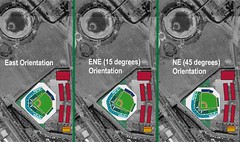The large red block at the top is a "big box" retailer, such as Target. Target or Kohl's would be prime candidates, since both are expanding aggressively, and neither currently serve Oakland. Target even has an unusual situation where two stores in San Leandro are only about a mile apart, making one a potential relocation candidate. (Note: These companies are just examples based on their profiles - they aren't endorsements of a particular store or its products.)
The 4 long blocks are for mixed-use retail/housing. The look would be similar to Santana Row in San Jose or Bay Street in Emeryville - open air shopping "district" with ground floor retail/restaurants and housing above it on 2-5 stories.

The orange/gold block on the bottom is a 300-room high-rise hotel. Hilton, who frequently works with Lewis Wolff, may be looking to move up from the dated Oakland Airport Hilton, and this site would be much more of a destination than the current Hilton is.
Integration with the stadium would be in the form of a large outfield plaza with a gate in center. The concept is similar to what is being planned for the new Busch Stadium. Nominal amounts of surface and/or garage parking would be required.
The advantage of a plan like this is that it completely transforms the streetscape on one side of Hegenberger. New developers could be spurred to develop on the other side. The Pak n Save supermarket across the street could be in line for an upgrade, or it could transform into a more upscale Safeway, who happens to be Pak n Save's parent company.
There are more than a few disadvantages. First is the fact that Hegenberger Gateway presents built-in competition. HG will also be a litmus test for the potential of retail in the Coliseum area. If retail space doesn't get filled up and if impressive sales figures don't come over the next year or two, fewer companies will be interested in placing a presence in East Oakland.
Then there remains the issue of cost. If someone were to want to develop all of it in a short timeframe - say, 3-4 years - the price tag would be enormous. How much? The ballpark costs $280 million. The retail and housing part, maybe $300 million. The hotel, probably $100 million. Garages - another $10 million. So the total cost of this project would come close to $700 million! And that doesn't even count whatever infrastructure improvements would be pledged by the City. (These figures come from published costs of other similar projects.)
Success would be a double-edged sword. Gentrification of the area would lower crime rates, bring better quality services and drive up property values, but it could also drive up rents, forcing lower income residents out of the market. San Francisco's SoMa neighborhood is the most notorious example of this phenomenon.
Going back to funding, one-shot building is probably not the way the project would be approached. Instead, the stadium and perhaps either the big-box retailer or the hotel would act as anchors to attract further privately-funded development.
Oakland City Councilmember Larry Reid has shown interest in spurring development in the Coliseum area via a new ballpark. Reid will have to carry the torch for any ballpark project, regardless of the size. No matter how much Wolff wants to control the process, he will need someone on the inside to go to bat for him. I have a hard time believing that a new ballpark won't require some sizable amount of public funding.

0 comments:
Post a Comment